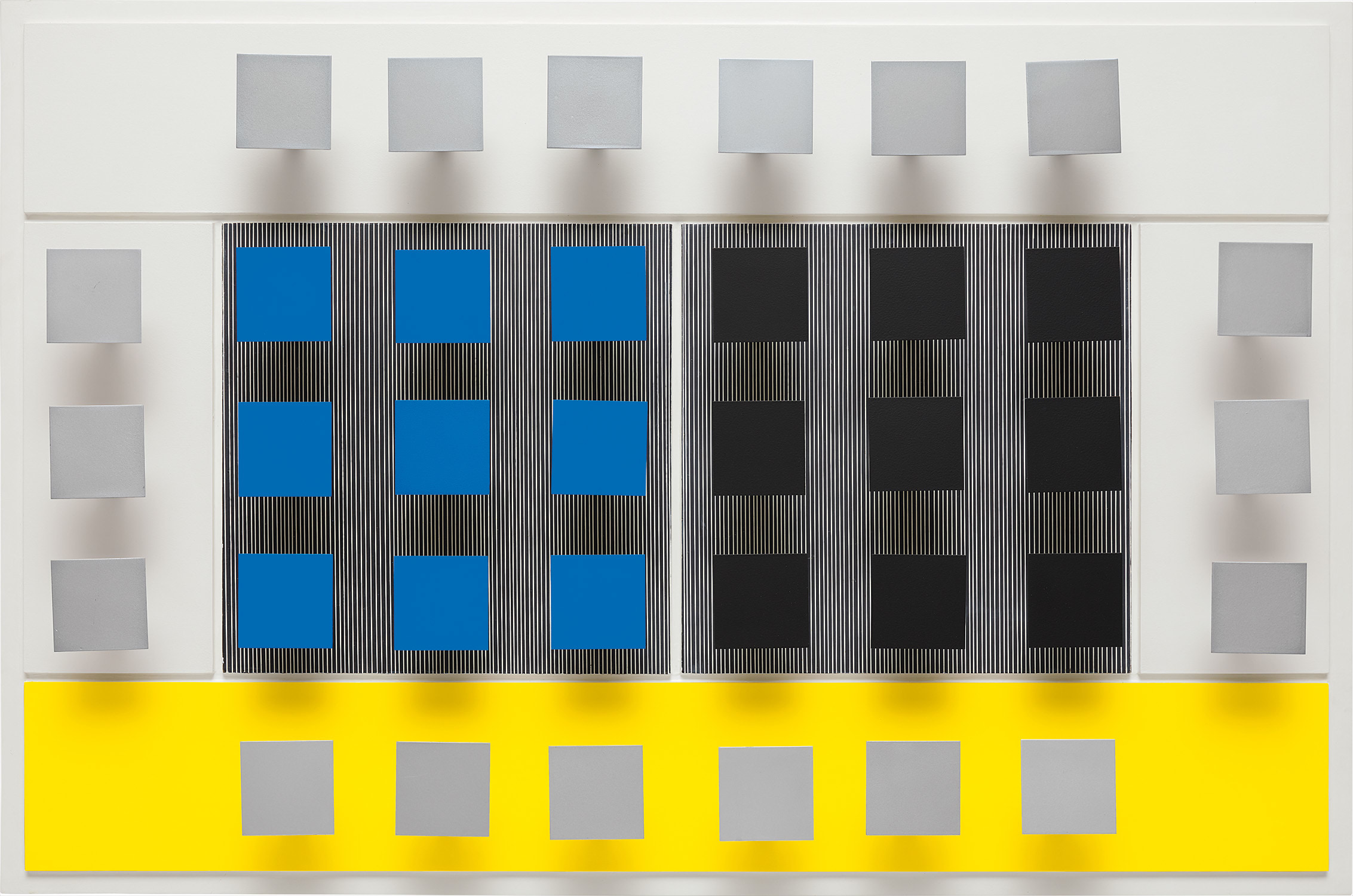

16
Jesús Rafael Soto
36 Cuadrados con banda amarilla
Full-Cataloguing
By this time, Soto had already established himself as a renowned artist in the international scene as a result of his first retrospectives at the Museum of Modern Art in Paris in 1969 and many exhibitions in galleries around the world. I collaborated in the organization of SOTO: A Retrospective Exhibition at the Solomon R. Guggenheim Museum, New York in 1974. Subsequently, I then became Soto’s Manager and carried out a series of projects and activities related to his work where we developed significant relations with the artistic intelligentsia of the time. This included Thomas M. Messer, The Director of the Guggenheim Museum, Claude Renard, Charles Cowles, Leo Castelli, Denis René, Sergio Camargo, Arman, Alviani and Ernst Beyeler among others. These relationships led me to organize a series of Soto’s most important exhibitions which include: Soto, at the Velázquez Palace, Madrid in 1982; Soto-Cuarenta años de creación: 1943-1983 at the Museum of Contemporary Art, Caracas in 1983; Soto: Space Art at the Center for The Fine Arts, Miami in 1985, and Soto, a travelling exhibition that started at the Museum of Modern Art in Kamakura, Japan and ended in the Museum of Modern Art in Itami, Japan in 1990.
In 1978, Alfredo Boulton, Soto and I, founded Estudio 1, a company dedicated exclusively to represent Soto’s work in international activities. Estudio 1 also included the production of graphic editions and multiples, as well as publishing his exhibition catalogues. In 1979, with Alfredo Boulton and Carlos Cruz-Diez, we founded Ediciones Macanao, dedicated to publications about the extensive art history of Venezuela.
A piece that has been widely exhibited in significant exhibitions, 36 Cuadrados con banda amarilla (1969) is an extraordinary example within Soto’s incredibly prolific career that evinces the caliber of his work and innovates the aesthetic and interactive experience the viewer has through a kinetic effect. In order to understand the present work, it is important to look back at the year 1957, as it marked a new stage in Soto’s oeuvre where the viewer’s gaze was no longer projected on the traditional plane. There is a rupture of the plane and the plane now serves as a background that Soto would layer with Plexiglas in order to draw in space, as seen in Transformable Harmony (1956). This was also the first time he would superimpose a metallic element, in the case of Transformable Harmony he used metallic rods over the background weavings. Furthermore, and as part of his ongoing exploration of materializing the ephemeral, inspired by Malevich’s Supremacist Composition: White on White (1918), Soto’s primary focus now changed to involve the viewer physically and visually, through the arrangement of pictorial planes, scale and colour, in a variety of mediums. One major change in his displacement of pictorial planes was by eliminating the use of Plexiglas to draw in space and recur to other elements. His necessity to involve the viewer allowed him to dominate time; regulating life as they acquired vitality as the spectator absorbs the piece’s dynamism when moving.
This constant investigation resulted in a series of works including, 36 Cuadrados con banda amarilla (1969) that strengthened even further his preoccupations. In this work, the black and blue square planes juxtaposed over the meticulously striped background, seemingly vibrate, while being surrounded by the luminous silver squares projected over the yellow and white background. This work is a primordial example in which Soto solidified his search that to my knowledge ended in the 1980s with his colorful Ambivalencias. These Ambivalencias ultimately liberated Mondrian’s approach of the static plane.
The year 1969 marked yet another crucial moment within Soto’s oeuvre because works such as 36 Cuadrados con banda amarilla anticipated his Penetrables, a series that marked a transcendental moment in art history in which a spectator first physically entered a work of art. Not surprisingly, the present work was exhibited in a seminal exhibition at The Museum of Fine Arts Houston, Soto in Houston, held in conjunction with Soto: The Houston Penetrable, in 2014. Guy Brett aptly described the importance of works such as the present work as the interrelation of the real and the imaginary, where the “real and imaginary is an optical experience, seen by a detached observer” (Guy Brett, Jesús Rafael Soto, Marlborough-Gerson Gallery, New York, 1969, p. 16). In both Soto’s Penetrables and 36 Cuadrados con banda amarilla, the works “oscillate between the abstract world of relations and the world of things. Unpredictable currents from the world of things activate and bring to life the paintings space” (Guy Brett, Jesús Rafael Soto, Marlborough-Gerson Gallery, New York, 1969, p. 16).
Jesús Rafael Soto
Venezuelan | B. 1923 D. 2005Jesús Rafael Soto was born in Ciudad Bolívar and studied at the School of Visual and Applied Arts in Caracas. During this period he became acquainted with Los Disidentes, a group of artists that included Alejandro Otero and Carlos Cruz-Diez. In addition to his fellow compatriots, Soto’'s work was influenced by Kazimir Malevich and Piet Mondrian.
The main artistic tenets evinced in Soto's works are pure abstraction, vibrations, progressions and geometric rigor. They can be seen through the use of lines and superimposed squares in his sculptures, made with paint and a series of industrial and synthetic materials. He spent much time in Europe, becoming a key member of the Group Zero movement, which included such artists as Lucio Fontana, Gunther Uecker and Yves Klein. As a result, Soto's work also incorporates modernist concepts such as light, time, movement, color manipulation and space. All of these facets place him as an important figure within the Kinetic and Op Art movements.